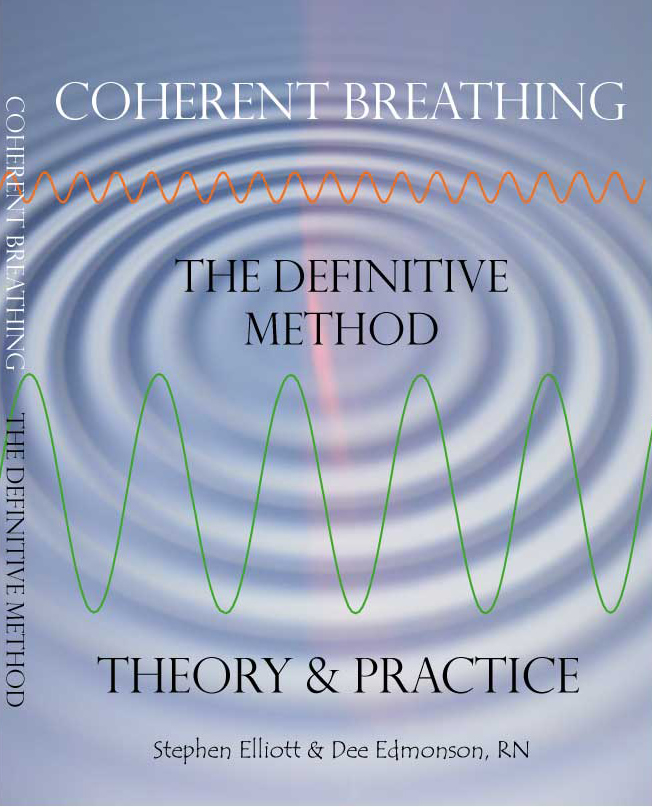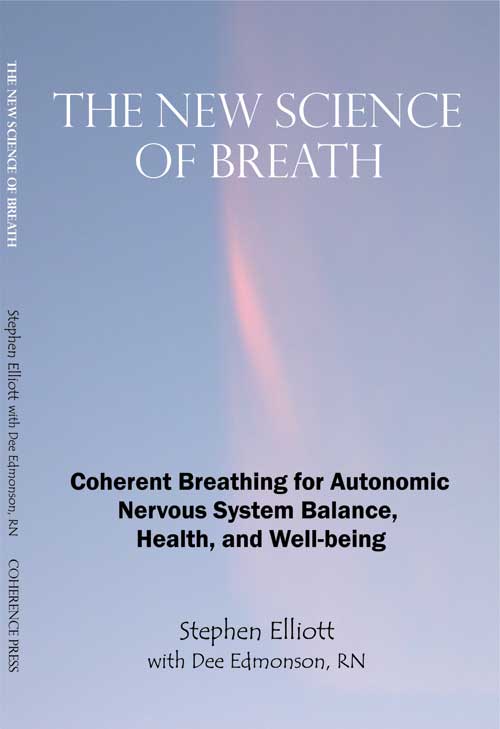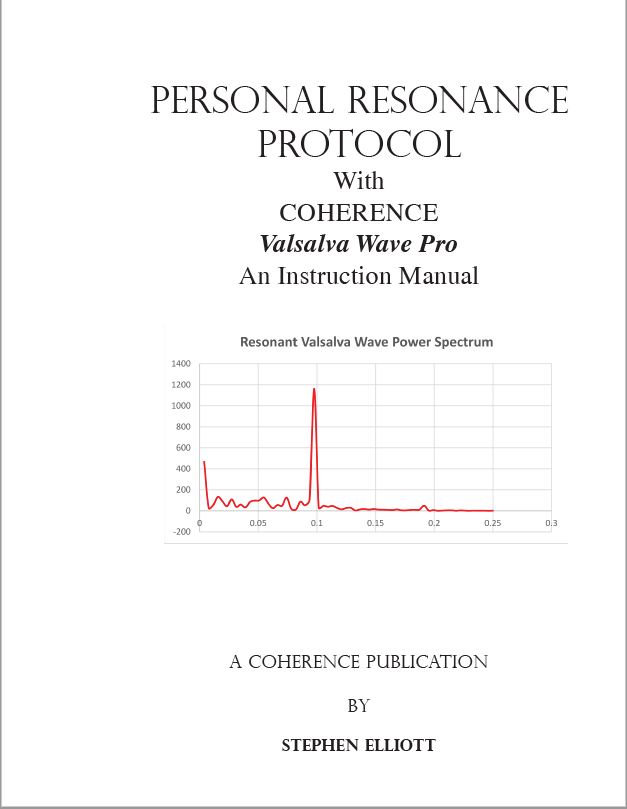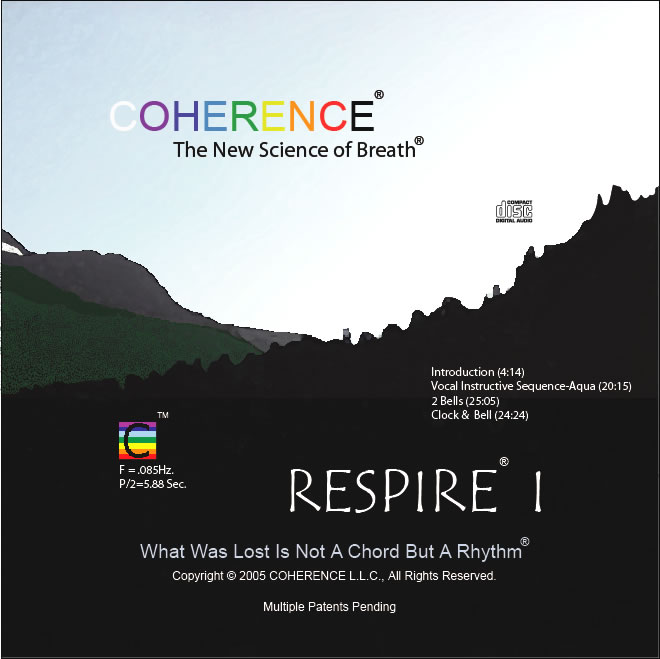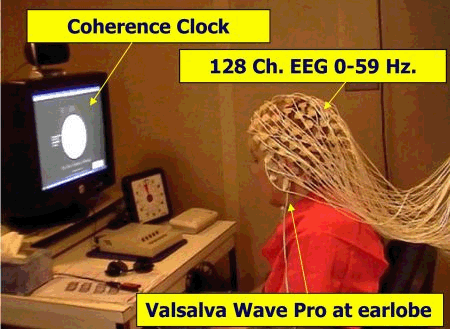
Stephen Elliott, President & Life Scientist, COHERENCE
Birth Date: November 13, 1952
Birth Place: New Orleans, Louisiana
Occupation: Author, Engineer, Inventor, & Life Scientist
Nationality: American
Alma Mater: Murray State University, School Of Applied Science – B.S. Electronics, Custom Program For Technical Managers – University Of North Carolina, Custom Executive MBA – Duke University, Center For Creative Leadership – Core Program
Notable Written Works: The New Science Of Breath (2005), Coherent Breathing – The Definitive Method (2008), both with Dee Edmonson, RN, BCIAC-EEG, Wuji Qi Gong & The Secret Of Immortality (2010) with Dr. Meng-Sheng Lin, Personal Resonance Protocol (2016), and the periodicals Coherent Breathing and Swan & Stone. Visit the Swan & Stone Channel and the recent YouTube addition, The Coherent Breathing Channel.
Discography: RESPIRE-1, The Six Bridges, SLOW Down!
COHERENCE IS PLEASED TO BE A NON-PROFIT SUPPORTER OF THE VETERAN’S ADMINISTRATION.
Stephen Elliott (born November 13, 1952) is an American author, engineer, inventor, and life scientist. He is the principal author of 4 books and is the author and publisher of the periodicals ”Swan & Stone” and “Coherent Breathing”. He is credited with the development and articulation of the Coherent Breathing method and with the plethysmographic detection and biofeedback of the respiratory arterial pressure wave phenomenon (US Patent #7922664). Elliott and Dr. Robert Grove of J&J Engineering named this known but little recognized wholistic phenomenon, blood flow rising in the arterial tree during exhalation followed by blood flow rising in the venous tree during inhalation, “the Valsalva Wave”, after Antonio Maria Valsalva, the 17th century Italian anatomist, “A” followed by “V” relating to “arterial” flow during exhalation followed by “venous” flow during inhalation, respectively. Antonio Valsalva was one of the first recorded Western observers of the respiratory arterial pressure wave phenomenon. |
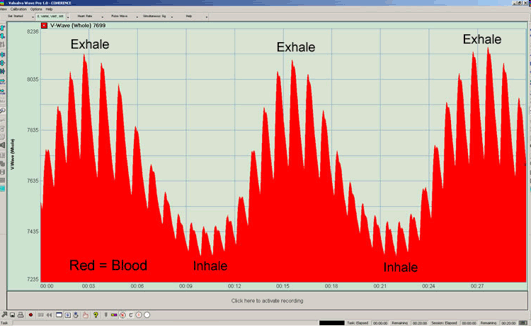
Elliott first described Coherent Breathing on the website coherence.com in May 2005. In late 2005, the information was incorporated into The New Science Of Breath, 1st Edition. Elliott revised the book to produce the 2nd edition in 2006, which introduced the theory of the respiratory arterial pressure wave and its relationship to the phenomenon of Heart Rate Variability (HRV). Note that “sinus rhythm” is a common medical term that describes a sinusoidal rhythm of the variation in heart rate, but its origin is virtually unknown to modern Western medicine – here I mean the origin of “sinus rhythm”. In fact, this is not true, its origin is known but has been overshadowed since ~1940, when “modern” Western medicine began to dominate the paradigm. China’s Yellow Emperor knew about sinus rhythm 5000 years ago. Its origin is diaphragm movement or “breathing” which is fundamentally “sinusoidal” in its action. The bottom line is that effective “breathing” and its result “sinus rhythm” are necessary for health. “Breathing is a circulatory function during which gas exchange occurs.” (Stephen Elliott, 2017)
With the release of Personal Resonance Protocol in the spring of 2016, Elliott incremented the formal definition of Coherent Breathing for the first time since 2006 with the addition of “sinusoidality of diaphragm motion”, which argues that ideal resonant breathing requires that the diaphragm move in a manner emulating the pendulum, the pendulum analogy having been introduced in the first edition of New Science Of Breath in 2005. Elliott argues that sinusoidal movement is a requirement for resonance that approaches the ideal and that sinusoidal motion of the diaphragm ultimately creates sinusoidal wave action in the circulatory system, the “Valsalva Wave”, which in turn results in sinusoidal rhythm of the heart rate variability (HRV) cycle via the well established physiological phenomenon of baroreception.
Unlike the popularized understanding, Elliott argues that the heart does not produce “a wave” which is “HRV”, that in fact HRV itself is not a wave, it is a graph of heart rate, a mathematical abstraction. The real wave is produced by the lungs filling and emptying under control of the diaphragm via the phrenic nerve. Heart rate variability is a consequence of vagal nerve communication with the heart’s sinoatrial node as a function of the Valsalva Wave rising and falling, the heart slowing as the wave rises in the arterial tree and heart rate increasing as the wave falls in the arterial tree.
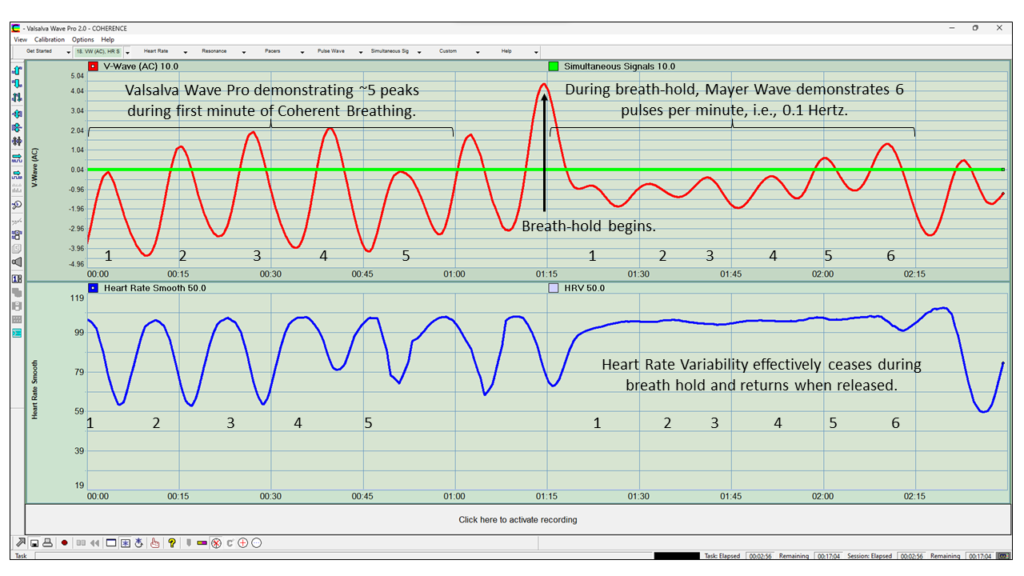
Valsalva Wave Pro demonstrating Coherent Breathing followed by the Mayer Wave during breath hold.
In the 2009–2012 timeframe, Elliott and colleague Estate Sokhadze, PhD., of University of Louisville School of Medicine, planned and conducted parallel experiments seeking to “find the wave in the brain”, Sokhadze examining the correlation between the blood wave at the earlobe produced by Coherent Breathing using Elliott’s patented wideband plethysmographic instrument and a 128 channel wideband electroencephalographic (EEG) instrument at the scalp.
Elliott’s experiment was to examine the correlation between the blood wave at the earlobe produced by Coherent Breathing with the wideband hemoencephalography record recorded at the forehead. Their conclusion was that the brain does experience the respiratory arterial pressure wave and that it correlates highly with that viewed at the earlobe. Sokhadze’s results demonstrated that the brain produces very large waves, approximately 10 times the amplitude of functional brainwaves (beta, alpha, theta, and delta) in the EEG when the respiratory arterial pressure wave is present at the earlobe. Elliott presented the results of their research at the 2013 annual meeting of the International Society For Neurofeedback And Research (ISNR) in Dallas, Texas. In all, Elliott and colleagues have asserted a new understanding of the role and function of “breathing”, this being that diaphragm movement facilitates the circulation of blood (5 liters in the average adult body) via filling of the lungs with blood via the right heart during inhalation and emptying of the lungs of blood via the left heart during exhalation, movement of the diaphragm modulating the pressure in the thoracic cavity in which both lungs and heart reside. During inhalation blood and air meet across the extremely thin alveolar surface to facilitate the exchange of carbon dioxide for oxygen. During exhalation, while gas exchange continues, blood and air go their separate ways, pulmonary blood exiting the lungs via the pulmonary vein, destined for the left heart and air leaving the lungs via conducting airways. The emerging understanding is that the circulation of blood facilitates the circulation of the remaining 37 liters of fluid in the average adult body, this being cellular fluid (28L), extra-cellular fluid (9L), cerebrospinal fluid, and other specialized fluids of the body, all of which rely on variation in blood flow and pressure to move. Observations of the Valsalva Wave in the capillary circulation suggest that blood flow and pressure double when breathing is resonant, exerting two times the motive force within the fluid environment of the body. |
Circulatoy Physiology
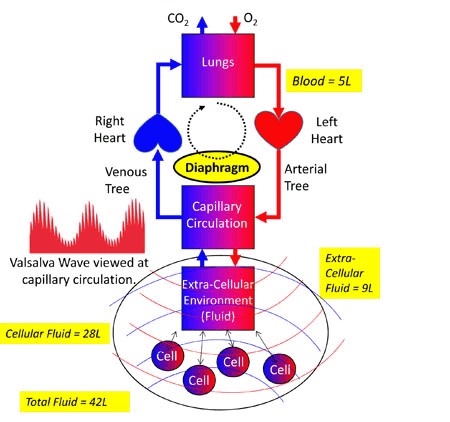
Background

Elliott, aided by clinician and colleague Dee Edmonson, RN, BCIAC-EEG began employing prototype “Coherent Breathing” audio recordings in the 2002 timeframe, in combination with multiple simultaneous forms of biofeeback including heart rate variability (HRV), electroencephalography, electrodermal response, and hand temperature, evaluating the quantitative effect that “Coherent Breathing” had on these simultaneous biomeasures as well as client physical and mental state, Edmonson’s findings corroborating Elliott’s. A number of these case observations are documented in The New Science Of Breath (2005) and in Coherent Breathing – The Definitive Method (2008). Elliott and Edmonson went on to share their research at consecutive annual meetings of the International Society For Neurofeedback And Research (ISNR) and the Association Of Applied Psychophysiology And Biofeedback (AAPB) during the 2006-2008 time frame, which is how knowledge of the Coherent Breathing method initially disseminated among health professionals. Many of the findings are explained in articles on Coherent Breathing Compendium.
Career
Elliott was employed as a telecommunications engineer by Northern Telecom in 1980 and became a Member, Scientific Staff of Bell Northern Research in 1982, the R&D subsidiary of Northern Telecom Limited, Canada. An electrical engineer by profession, Elliott was assigned responsibility for the growing DMS-100 Hardware Development group at the Bell Northern Research (BNR) Research Triangle Park (RTP) laboratory, including functional and electrical design and development of electronic subsystems, boards, chips, and firmware. During his tenure with Bell Northern Research, Elliott held technical and managerial assignments in the RTP (North Carolina), Maidenhead (U.K), Ottawa (Canada), and Richardson (Texas) laboratories. In 2002, Elliott was appointed to the position of Chief Technical Leader, Wireline Networks 1 of 4 positions reporting to a Line Of Business President and the Chief Technology Officer, responsible for setting strategic product and technology direction. Elliott resigned in 2004 from what had become “Nortel”, the integration of Northern Telecom with Bell Northern Research and formed both COHERENCE LLC and Techno-Business LLC.
Elliott has 19 US patents issued in fields of telecommunications and life sciences and has been the President of COHERENCE LLC since its inception in 2004.
Elliott’s present research interests lie in the area of of the vertebrate evolution and the relationship between diaphragm sophistication and erectness, where Elliott’s thesis is that the diaphragm evolved with erectness to aid in the movement of blood upward from legs to chest and from chest to brain, against gravity. Elliott’s hypothesis is that “breathing well” is necessary for the human brain to function – and evolve – properly, hence, the necessity to breathe well – it affects your brain function/IQ, immune function, general well-being, and longevity.

In January 2017 with the cooperation of the Dallas Zoo, Elliott was able to instrument “Jade” a 12 year old female giraffe with the COHERENCE instrument Valsalva Wave Pro, which he attached to the tip of Jade’s tongue while she was sedated for a hoof trimming procedure. In 2009 Elliott asserted the hypothesis that the giraffe’s diaphragm (which is the largest of any land mammal relative to its body mass) plays a vital role in blood being able to reach the girafffes head and brain, this at a time when, while there had been numerous attempts to understand the physics of giraffe circulatory physiology, the riddle of how blood makes it to the giraffes head successfully against gravity, where the giraffe heart is no larger than any other land mammal’s heart relative to its body mass. Previous studies had all employed invasive catheterization and eventual loss of life.
With this single visit, Elliott believes that the riddle has been solved, this being that the giraffe’s “thoracic pump”, a sealed system comprised of the chest walls, lungs, heart, and bounded at the bottom by the diaphragm, pumps blood upward toward the giraffe’s head (and downward to its legs) with every exhalation (upward movement of the diaphragm), and downward from the giraffe’s head (and upward from its legs) with every inhalation (downward movement of the diaphragm). Downward movement generates a vacuum in the chest to which venous blood naturally flows, filling and expanding the lungs. Upward movement generates positive pressure in the chest causing the lungs to shrink via elasticity and ejecting the blood collected during inhalation into the pulmonary vein and onward to and through the giraffe’s heart to its carotid artery and further upward to its head and brain. [It is important to note that this same function exists in humans and other mammals but not to the degree that is does in giraffes, this being due to their extreme verticality, the length of their necks and legs, and their massive powerful diaphragms.]
And there is a very special adaptation to breathing that the giraffe alone possesses – described below.
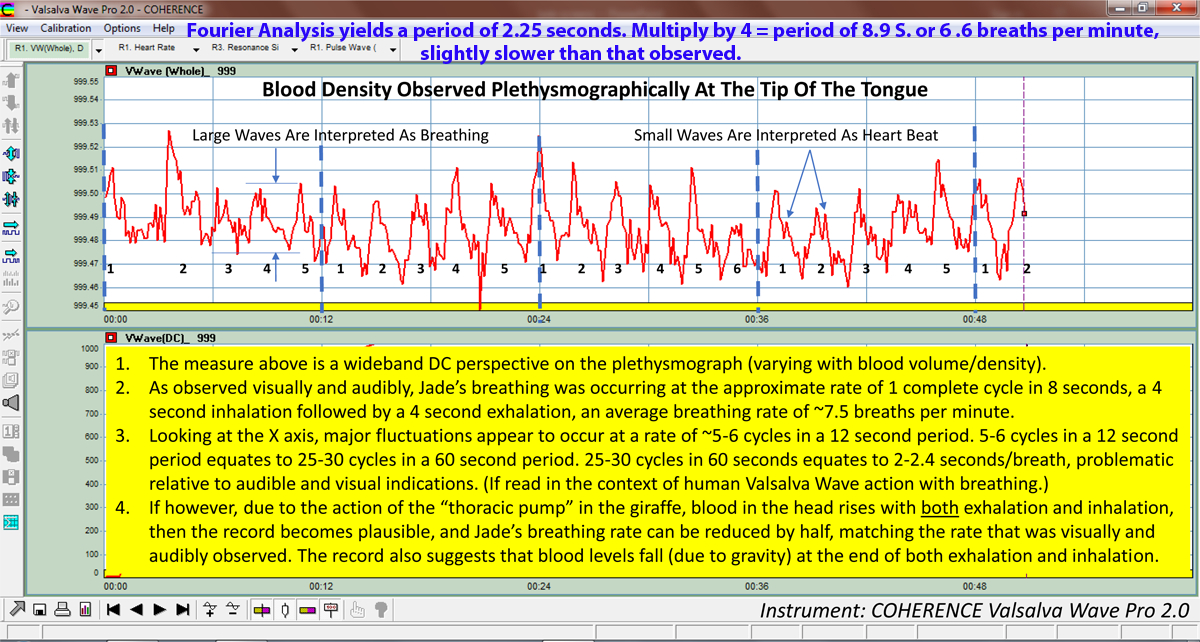
The existence of “the respiratory arterial pressure wave” is known to medicine – but hardly recognized. The existence of its parallel on the venous side is unknown to medicine, what we could call “the respiratory venous pressure wave”, both of which can easily be observed in humans when we are in an erect body position using Valsalva Wave Pro. Elliott posits that the record of Jade represents a breakthrough in understanding that solves the riddle. The solution is that the giraffes powerful diaphragm and thoracic pump pushes blood up the neck via the carotid artery during exhalation and vacuums blood up the neck via the carotid artery and ultimately via the jugular vein during inhalation, the whole time diaphragm activity aiding the heart, where the giraffe heartbeat is barely visible in the head. All one sees with a plethysmograph at the tip of the tongue is relatively giant waves associated with inhalation and exhalation, indicating that both inhalation and exhalation are causing blood volume in the head to rise, resulting in continuous blood flow through the giraffe head and brain – all enabled by its diaphragm movement. The story of this research can be found here: Jade – A Thesis On Giraffe Circulatory Physiology and on the Swan & Stone and Coherent Breathing channels. Elliott invites the giraffe zoological community to consider this explanation critically and to reproduce the experiment. While there is inevitably much to be learned from giraffe circulatory physiology, we already know much about human cardio-pulmonary-circulatory physiology that must be considered in future giraffe experiments, this being that diaphragm action and its associated “thoracic pump” move the blood, probably moving it alot more in giraffes than in humans, given the evolutionary imperative.
Also find Stephen Elliott at: Qi Yi Shu -Chi Arts- Esoteric Knowledge & Training With Stephen Elliott – Qi Yi Shu – Chi Arts
Elliott authors and publishes Coherent Breathing, an occasional journal of complementary solutions for health, well-being, and longevity and is the newly established COHERENCE on-line magazine.

Stephen sees clients for health enhancement or Practitioner Training at Acupuncture Center in Richardson, Texas by appointment. Contact Stephen at steve.elliott@coherence.com. Be sure to include “Appointment” in the subject line of your email and include your phone number if you would like a call back. Thank you.
Stephen sees clients for health enhancement or Practitioner Training at Acupuncture Center in Richardson, Texas by appointment. Contact Stephen at steve.elliott@coherence.com. Be sure to include “Appointment” in the subject line of your email and include your phone number if you would like a call back. Thank you.
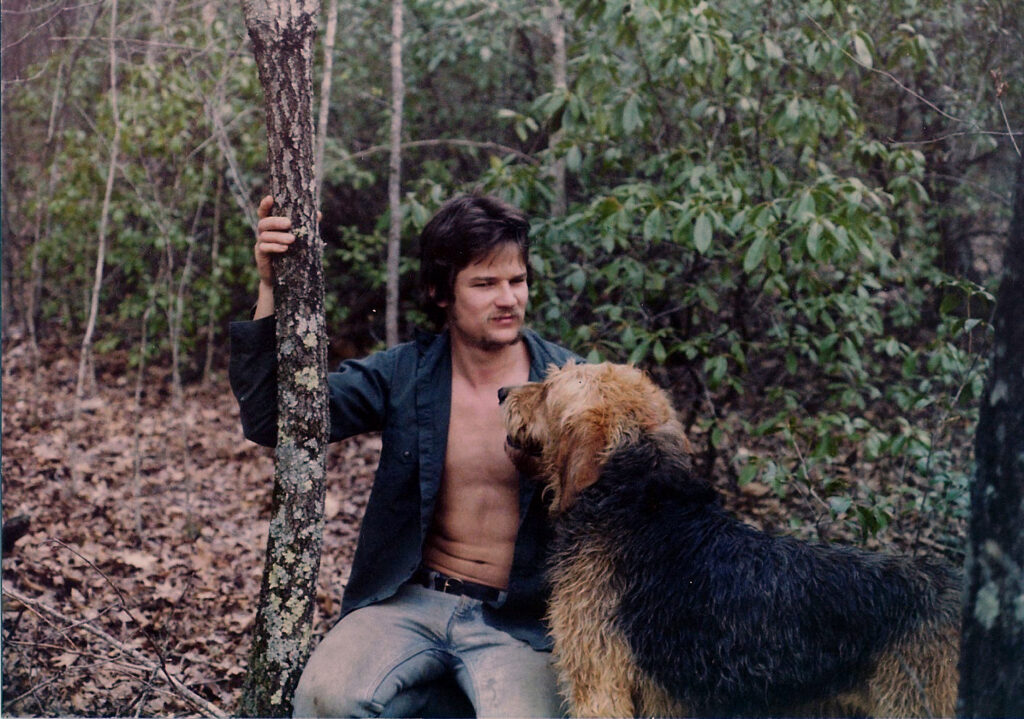
Stephen Elliott, younger days in Bear Creek, North Carolina.
Coherent Breathing Books
